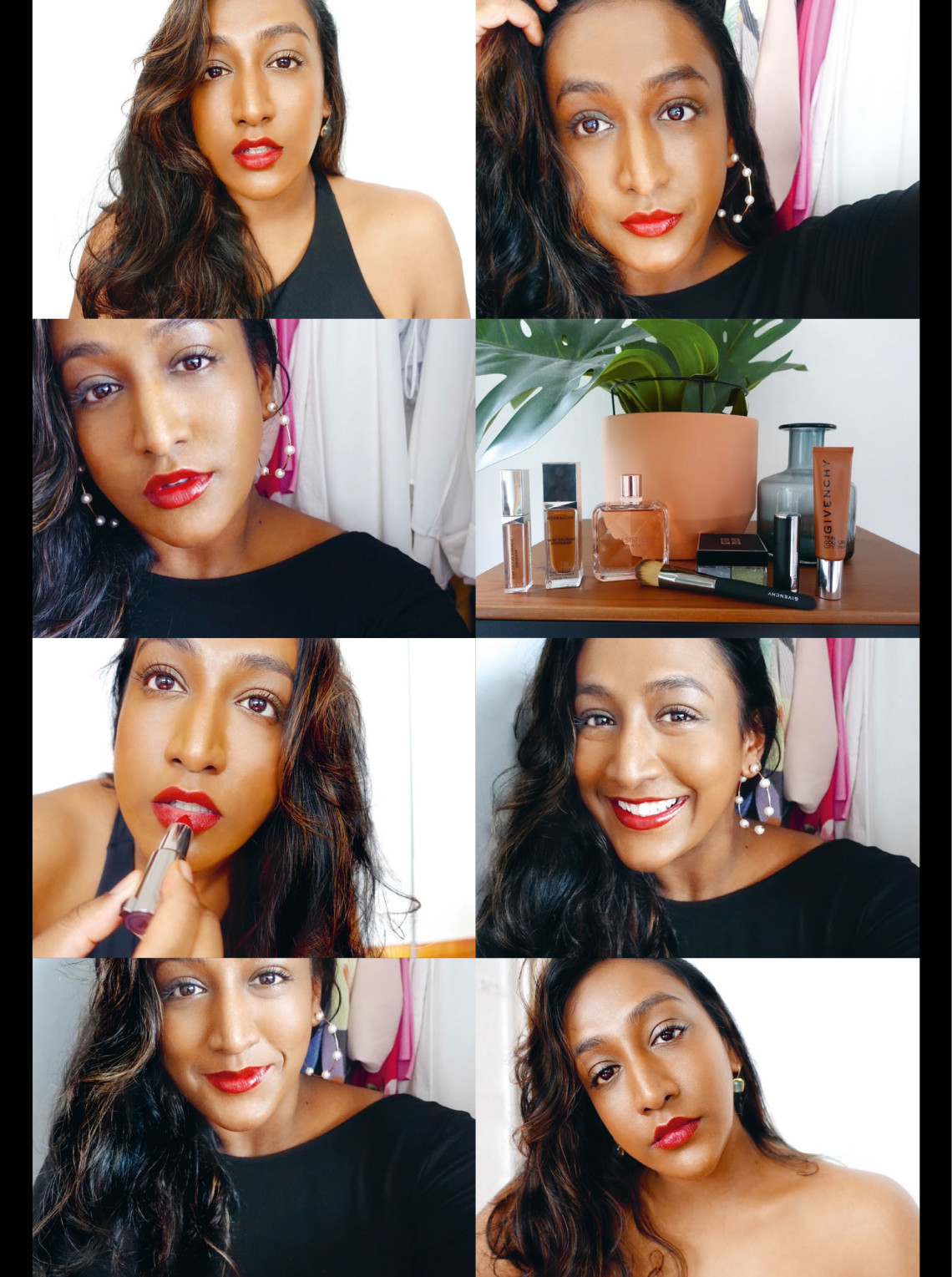HAS WORK-FROM-HOME CULTURE TAKEN THE MAGIC OUT OF WOMEN’S MAKEUP ROUTINES (AND THE COSMETICS INDUSTRY IN GENERAL)? BEAUTY BUFF AILEEN LALOR ZOOMS IN ON WHAT COVID HAS MEANT FOR THE LIPSTICK EFFECT.


HAS WORK-FROM-HOME CULTURE TAKEN THE MAGIC OUT OF WOMEN’S MAKEUP ROUTINES (AND THE COSMETICS INDUSTRY IN GENERAL)? BEAUTY BUFF AILEEN LALOR ZOOMS IN ON WHAT COVID HAS MEANT FOR THE LIPSTICK EFFECT.
While she used to never leave home without a full face of makeup, freelance beauty writer Sofia Kim says WFH culture has made her simplify her routine and enjoy wearing less. “When I do head out these days, I’d just do my brows and use a tinted sunscreen or tone-up cream, blusher and lipstick.” Kim wears Clarins’ Milky Boost foundation that’s said to hydrate for eight hours; Joli Blush in Cheeky Pinky and Twist To Glow powder in Glowy Coral for a light, pretty flush; a hint of Ombre Satin eyeshadow in Purple Rain and Lip Milky Mousse tinted lip care in Milky Strawberry. All clothes and accessories, subjects’ own
In my youth I was experimental with makeup, but as an adult I settled – as most people do – into a pattern. Everything was anchored around red lipstick. I wore foundation, two different concealers, brow gel, mascara, blusher, and a touch of highlighter and shimmering eyeshadow every day.
As a staunch feminist, I was confident that I did all this for myself, not anyone else’s pleasure, so I reasoned that working from home wouldn’t change my relationship with makeup. It didn’t quite work out like that.
After just a few days, I had abandoned everything but the lip. It wasn’t that no one saw me except my nearest and dearest. In fact, I was more visible than ever thanks to seemingly endless Zoom calls. And it wasn’t that my skin was markedly better as a result of staying home. The stress and lack of sleep were causing eczema, hormonal breakouts and dark circles that a raccoon would envy.
A lot of it came down to the explosion of usual routines – not least, having nowhere to go. Applying a full face of makeup to commute three steps to my desk seemed faintly ridiculous and, anyway, what did time even mean? As Faz Gaffa-Marsh, a writer and digital marketer, puts it: “My days all fused into one – there was almost no night and day during the circuit breaker (CB) – and I rarely went out.”

Digital marketer Faz Gaffa-Marsh went makeup-free during the circuit breaker, which has only made her enjoy getting dolled up even more now when she gets the opportunity to. Products she has on here include Givenchy Beauty’s Teint Couture Everwear Foundation in Y400; imperfection-blurring, radiance-boosting Prisme Libre Loose Powder in Mousseline Acidulee; luminous matte Le Rouge Couture lipstick in the best-selling L’Interdit; and Le Rose Perfecto Beautifying Lip Balm.
An Influenster survey suggests that most of us have changed our makeup habits due to the pandemic. Fifty-seven percent of its 1,000-plus respondents were consistently wearing less makeup and 21 percent ditched it entirely. “I truly didn’t touch my makeup for three months. In fact, I put them all in the fridge in hopes of extending their shelf life,” says Gaffa-Marsh. And, says PR maven Diana Ong, “I missed my makeup! I had such a sense of guilt when I looked at them – like ‘Oh poor babies! I’ve been neglecting you!’ I liked wearing makeup sometimes for happy hour sessions or meetings over Zoom, or put on a lipstick for no reason other than feeling like it. But the amount of makeup that I used definitely went down.”
Conversely – as with 8 percent of survey respondents – makeup artist Andrea Claire increased her usage of cosmetics while working from home. “This time hasn’t affected my relationship with makeup because makeup and I have always been best friends,” she says. During the CB, she even started an Instagram project called Covid Self-Portraits in which she experimented with products to showcase her skills. “Creative minds need to create!” she points out. Within her circles, makeup sales went up with plenty of clients reaching out for her beauty shopping lists, she adds.
From a consumer’s point of view, the biggest change lies in where we spend our dollars: online. Net-a-porter reported a huge increase in makeup sales for May with the biggest growth coming from foundation – sales were up 109 percent from last year. That makes intuitive sense: Pre-pandemic, there weren’t many people who would have confidently tried on foundation without swatching it on skin; now, we have no other option.
It’s also hard to see how IRL makeup retail will survive the pandemic. While it’s both practical and pleasurable to go into a store, see how something shimmers on skin and take it home immediately, who will risk dipping their fingers into communal pots and palettes in the foreseeable future?

For yoga teacher and part-time DJ Fiona Siew, WFH has meant conducting online classes and DJ sets on Instagram Live. “It’s made me pay more attention to skincare as well as learn about the colours and makeup techiniques that work for a virtual world where presence is very important,” she says. Products she has on here include Dior’s Diorshow 5 Couleurs Couture eyeshadow palette in #689 Mitzah with shimmery shades of brown and gold, Diorskin Mineral Nude Glow highlighter in #001 Pink Flame, Rouge Blush in #431 Peach Volley and Dior Addict Stellar Shine in the pretty coral-like #452 Ibis Pink from the brand’s recently launched Color Games line.
To that end, as Sephora reopened its stores, it figured out smart ways to replicate swatching with in-app services such as the augmented reality Virtual Artist, a Scan-to-Interact function that allows customers to learn more about any product and complimentary Zoom consultations. All that said, the Influenster survey suggests that 24 percent of people won’t be returning to IRL shopping; that goes up to 30 percent if sampling and swatching aren’t allowed.
What about whether we’ll go back to wearing makeup as we did before once we have somewhere to go? Claire points out that after major crises, lipstick sales typically increase – a much-studied economic phenomenon known as the lipstick effect. Gaffa-Marsh isn’t sure what’ll happen when things go back to normal (whatever that means). She does admit: “When I do get my face done up like I did last weekend for a shoot, it feels like a treat.”
All of which brings me back to my pout: Why did the red lip remain while everything else vanished? For me, it’s a symbol of everything good that the pandemic has brought – the chance to assess what we value and what we don’t. I don’t care much about mascara or elaborate eye makeup, but red lipstick is a joy – part of my identity even. This is the makeup I wear for myself: a flourish and a frivolity, completely unnecessary, but oh so enjoyable. And couldn’t we all do with a bit more of that these days?























